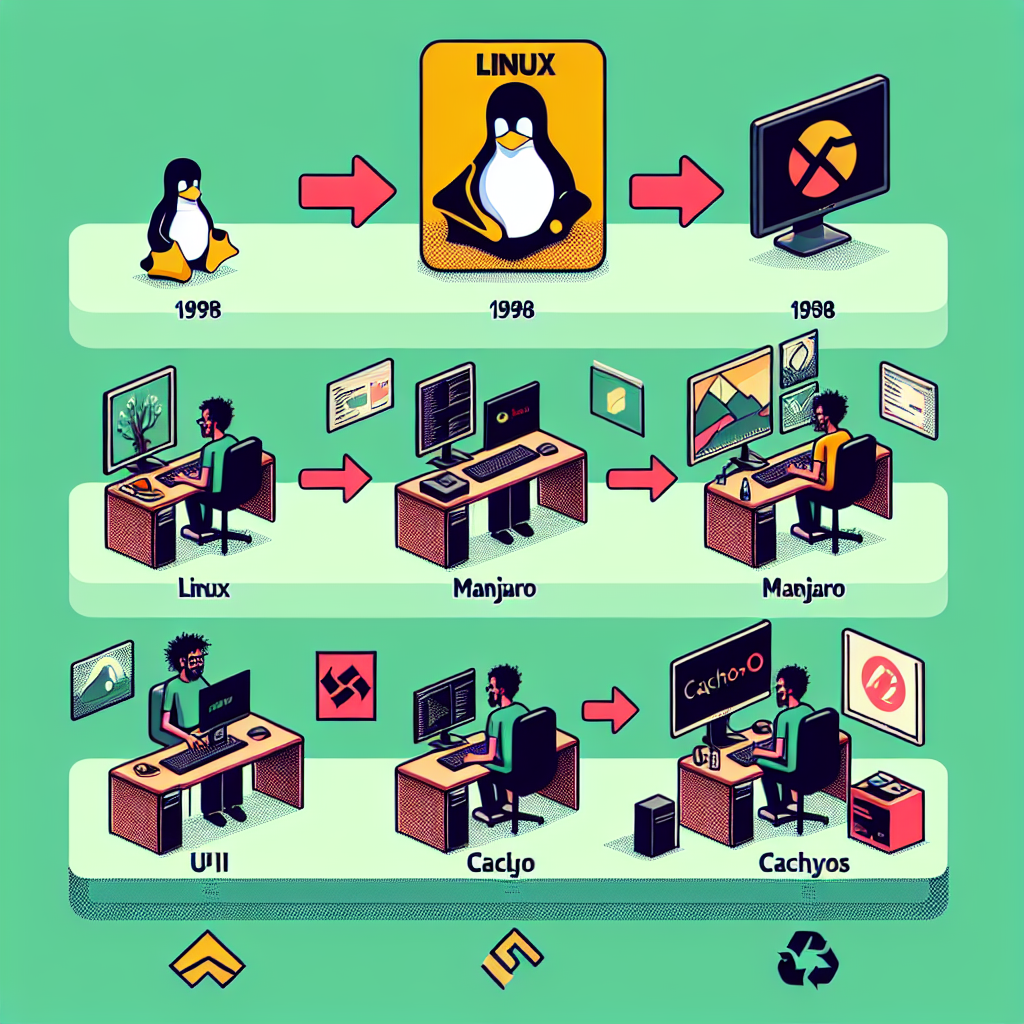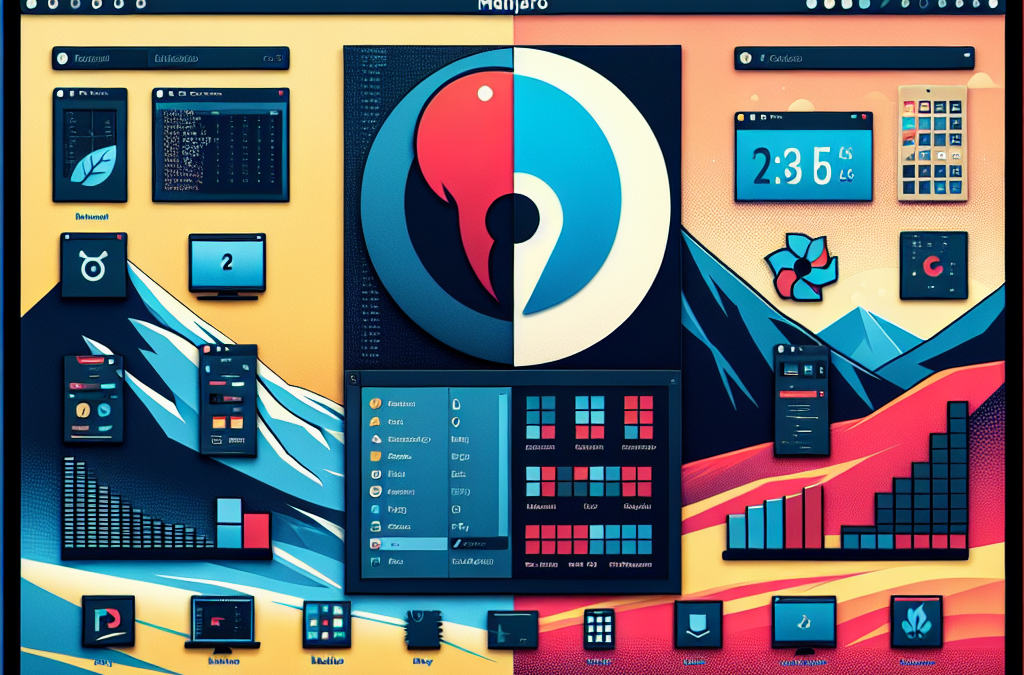Evolution of Linux Distributions: From 1998 to Manjaro and CachyOS
Since its inception in 1991, Linux has undergone a remarkable evolution, transforming from a hobbyist’s experiment into a powerhouse that drives much of today’s technology, from personal computers to servers and even mobile devices. My journey with Linux began in 1998, a time when it was still gaining momentum among tech enthusiasts. Over the years, I’ve witnessed firsthand the operating system’s growth and the community’s relentless innovation, which has led me to explore various distributions, most recently Manjaro and CachyOS.
Back in 1998, Linux was a different beast. Installation processes were often cumbersome, requiring a fair amount of technical knowledge. Hardware compatibility issues were common, and getting a Linux system up and running could be a challenge. Despite these hurdles, the sense of community and the open-source ethos made every struggle worth it. Users and developers from around the world contributed to forums, wrote patches, and shared knowledge, all driven by a passion for free and open-source software.
As the years progressed, so did Linux distributions. They became more polished and user-friendly, with Ubuntu and Fedora becoming household names. These distributions worked hard to lower the entry barrier for new users, offering graphical installers and out-of-the-box support for a wide range of hardware. This shift played a crucial role in bringing Linux to a broader audience, making it not just a system for developers and tech enthusiasts but also for less tech-savvy users.
In the last few years, my distribution of choice has been Manjaro. What drew me to Manjaro was its balance between accessibility and power. Based on the robust Arch Linux, Manjaro offers the same rolling release model and access to the Arch User Repository (AUR), but with a focus on stability and ease of use. Its user-friendly installation process, automatic hardware detection, and the choice of multiple pre-configured desktop environments make it a versatile choice for many users. Moreover, Manjaro’s community is vibrant and helpful, reminiscent of the early days of my Linux journey.
Recently, my curiosity led me to explore CachyOS, a newer distribution that has piqued the interest of many in the Linux community. CachyOS aims to optimize performance by using modern compiler technologies and offering various kernel optimizations. Although it is built upon the foundations of Arch Linux, similar to Manjaro, CachyOS focuses more on performance enhancements and bleeding-edge features. This makes it an exciting choice for those who want to push their hardware to its limits or who enjoy tinkering to get the most out of their system.
Transitioning to CachyOS over the past month has been an enlightening experience. It’s fascinating to see how different distributions prioritize different aspects of the user experience. Where Manjaro seeks to balance accessibility with power, CachyOS leans more towards performance, offering users the chance to engage deeply with their system’s capabilities.
Reflecting on these experiences, it’s clear that the evolution of Linux distributions is not just about technological advancements but also about catering to diverse user needs and preferences. From the early days of challenging installations to the sleek, performance-optimized environments of today, Linux continues to offer something unique for everyone. Whether you’re a newcomer or a seasoned user, the journey through its many distributions is a testament to the spirit of innovation that defines the Linux community.
Personal Journey with Linux: Experiences and Lessons Learned Since 1998

Since embarking on my Linux journey in 1998, I’ve witnessed an incredible evolution within this robust operating system. Starting with some of the earliest distributions, each step of my journey has been filled with learning and surprises, leading me to my recent experiences with Manjaro and CachyOS.
Back in 1998, Linux was a frontier for the tech-savvy and the curious. It was a time when installing Linux could mean hours of compiling kernels and configuring settings—a true test of patience and perseverance. However, the sense of community and the open-source ethos were compelling. There was a shared sense of building something transformative, away from the mainstream operating systems.
As the years progressed, so did Linux. It became more polished and user-friendly, with distributions like Ubuntu and Fedora leading the charge towards making Linux accessible to a broader audience. My personal transition to Manjaro a few years ago was a significant milestone. Manjaro, based on Arch Linux, provided a balance of cutting-edge software and stability that was hard to find. Its rolling release model meant that I was always up to date with the latest software developments without the need for major reinstalls.
Manjaro was a revelation. It offered simplicity through its user-friendly interfaces while allowing me to dig deep into customization when needed. The use of the Pacman package manager and access to the Arch User Repository (AUR) were particularly delightful, offering a vast array of software and tools with just a few keystrokes. This period also deepened my understanding of system security and resource management, crucial skills for any seasoned Linux user.
Recently, my curiosity led me to explore CachyOS, an even more optimized version of Arch that focuses on performance and efficiency. Over the last month, diving into CachyOS has been like rediscovering Linux all over again. CachyOS uses a custom kernel designed for performance, and it implements various patches and optimizations that ensure the system runs smoothly and swiftly, even on older hardware.
Transitioning to CachyOS from Manjaro was smoother than I anticipated. The Arch-based foundation of both distributions meant that much of my prior knowledge was still applicable. However, CachyOS’s emphasis on performance tuning and resource optimization offered new learning opportunities. It’s fascinating to see how even small adjustments in system configuration can lead to noticeable improvements in efficiency.
Reflecting on these experiences, the journey with Linux has been about more than just software; it’s been a continuous learning process that has kept pace with the evolving tech landscape. Each distribution has taught me something unique about what technology can do and how it can be molded to meet individual needs.
Moreover, the Linux community continues to be a source of inspiration and support. Whether it was troubleshooting a driver issue in 1998 or optimizing a kernel in 2023, the community has always been there, offering advice, sharing knowledge, and pushing the boundaries of what open-source software can achieve.
In conclusion, my journey with Linux from 1998 to the present, through Manjaro and now CachyOS, reflects not just a personal tech preference but a commitment to growth, learning, and community. Linux isn’t just an operating system; it’s a journey of continuous improvement and discovery. As I look forward to what the future holds, I am excited to keep exploring, learning, and contributing to this vibrant ecosystem.
Comparing Manjaro and CachyOS: A User’s Perspective
Since 1998, I have been navigating the vast and intriguing world of Linux, a journey that has allowed me to witness firsthand the evolution of this robust operating system. Over the years, I’ve experimented with various distributions, each offering its unique flavor and community. Most recently, my adventures have taken me through the terrains of Manjaro and CachyOS, two distributions that, while built on the foundational Arch Linux, present distinct experiences tailored to different types of users.
Manjaro, which I have used for several years, is renowned for its user-friendliness, especially appealing to those transitioning from more mainstream operating systems like Windows or macOS. It offers a balance of stability and cutting-edge software, a hybrid that is not often easy to achieve. Manjaro’s use of rolling releases means that you’re always up to date without the need for major reinstalls. This approach eliminates much of the hassle associated with software updates, making life a bit easier for users who prefer a set-it-and-forget-it type of system.
Moreover, Manjaro is highly customizable. It starts you off with a choice of several desktop environments such as XFCE, KDE, and GNOME, each with its aesthetic and functional nuances. This flexibility allows users to create a personalized workspace that feels comfortable and intuitive. Additionally, Manjaro’s hardware detection tool, MHWD, simplifies the process of installing necessary drivers, which is particularly beneficial for newcomers not yet comfortable with manual configurations.
Transitioning to CachyOS over the last month has been an enlightening experience. While it shares the Arch Linux pedigree with Manjaro, CachyOS focuses more on performance optimization and cutting-edge features. It targets experienced users who are not only comfortable with Linux’s complexities but also eager to exploit every ounce of efficiency from their system. CachyOS employs the CachyOS kernel, a modified version of the Linux kernel, optimized for performance with specific patches and enhancements that are not present in the standard Arch kernel.
One of the standout features of CachyOS is its commitment to providing a bloat-free environment. This is particularly noticeable in its minimalistic installation process, which allows users to install only what they need without unnecessary extras. This lean approach can lead to a faster system that feels more responsive and tailored to specific user needs.
Comparing Manjaro and CachyOS, it’s clear that each has carved out its niche. Manjaro offers a more accessible entry point into the world of Arch Linux, providing a safety net for those who might be intimidated by the prospect of a complex setup. Its user-friendly design and robust support community make it an excellent choice for both newcomers and seasoned users looking for stability without sacrificing the benefits of rolling releases.
On the other hand, CachyOS appeals to the tinkerers and performance enthusiasts who revel in fine-tuning their operating system to achieve optimal performance. Its performance-optimized kernel and minimalistic philosophy cater to a more niche but no less passionate audience.
In conclusion, whether you lean towards the user-friendly, stable environment of Manjaro or the performance-optimized, hands-on approach of CachyOS, both distributions offer valuable and distinct experiences within the Linux ecosystem. As someone who has traversed the landscape of Linux distributions, the journey through each new environment continues to be as rewarding as it is enlightening, filled with endless learning and customization opportunities.
The Future of Linux: Predictions Based on Over Two Decades of Usage
Title: The Future of Linux: Predictions Based on Over Two Decades of Usage
Since my initial foray into the world of Linux back in 1998, I have witnessed an incredible evolution within this robust operating system. From the days of grappling with command-line interfaces to the sleek graphical user interfaces of today, Linux has transformed in ways that were once unimaginable. Most recently, my journey has taken me from using Manjaro for several years to exploring CachyOS over the past month, each experience enriching my understanding of what Linux is capable of achieving.
Reflecting on these experiences, it’s clear that Linux’s adaptability and the vibrant community around it are key drivers of its enduring success. Manjaro, with its user-friendly yet powerful design, exemplifies how Linux distributions can cater to both newcomers and seasoned users. Its rolling release model ensures that users always have access to the latest software updates without the need for a complete system overhaul. This approach not only simplifies maintenance but also keeps the system fresh and responsive.
Transitioning to CachyOS, I’ve noticed a distinct focus on performance optimization and cutting-edge features. CachyOS employs a custom-optimized Linux kernel that is tailored to deliver enhanced performance and resource efficiency. This is particularly appealing to users who, like myself, enjoy pushing their systems to the limits while maintaining stability and speed. The shift towards performance-centric distributions like CachyOS suggests a future where Linux not only continues to be accessible but also increasingly powerful.
Moreover, the Linux ecosystem’s commitment to security and privacy remains a cornerstone that attracts users. With growing concerns over digital privacy, Linux’s transparent and open-source nature offers a reassuring alternative to proprietary operating systems. Users have the freedom to inspect, modify, and enhance their software, which not only educates but also empowers them to take control of their digital environments.
Looking ahead, I predict that Linux will further solidify its position in both enterprise and personal computing realms. The rise of cloud computing and the Internet of Things (IoT) presents new opportunities for Linux to shine, given its scalability and robustness. As more devices become interconnected, the demand for a secure and stable operating system that can handle complex networks will undoubtedly increase. Linux, with its myriad of distributions capable of being tailored to specific needs, is perfectly positioned to meet these challenges.
Additionally, the educational sector continues to embrace Linux, particularly in computer science and engineering disciplines. As educational institutions recognize the value of teaching open-source technologies, students are introduced to Linux at an earlier stage, which not only enhances their technical skills but also prepares them for a workforce that increasingly relies on open-source solutions.
In conclusion, my journey through the Linux landscape from 1998 to the present day has been nothing short of remarkable. From Manjaro’s user-centric approach to CachyOS’s performance optimizations, each distribution has contributed to a broader understanding and appreciation of what Linux is capable of. As we look to the future, the continuous innovation and community-driven development model of Linux suggest a bright and dynamic path ahead. Whether for personal use, educational purposes, or enterprise solutions, Linux is poised to remain a key player in the evolving technology landscape, bringing with it a promise of openness, innovation, and endless possibilities.
Discover more from Rune Slettebakken
Subscribe to get the latest posts sent to your email.


